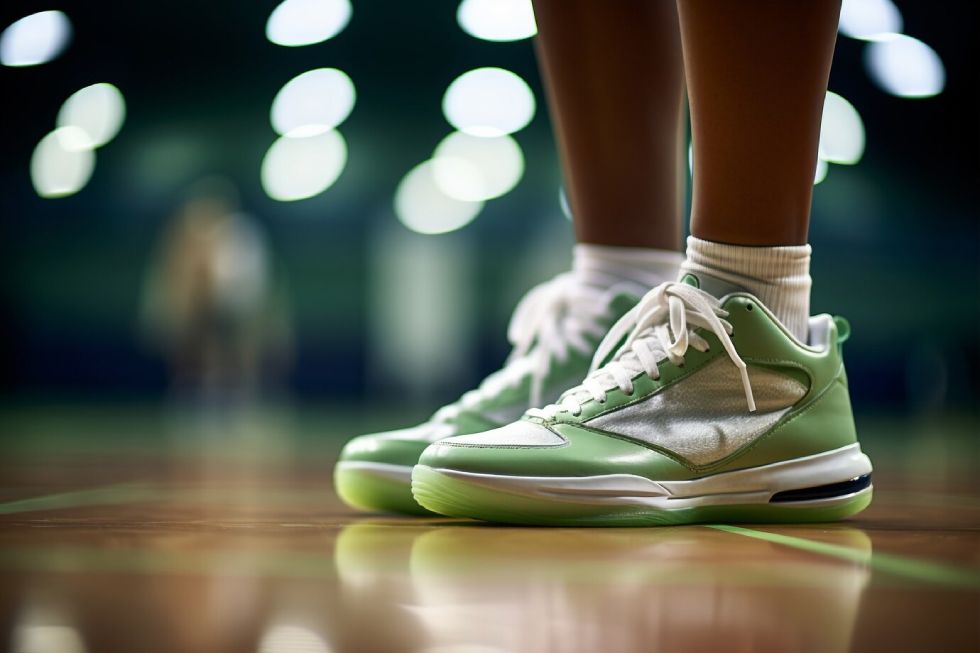
I. Introduction
When it comes to athletic performance, we often focus on the major muscle groups, the strength of our core, or the power in our legs. But what about our feet and ankles? These areas are crucial for nearly every sport, yet they’re often overlooked until something goes wrong. Athletes are no strangers to foot and ankle injuries—whether it’s a sprained ankle, tendonitis, or plantar fasciitis. These injuries can sideline even the most dedicated athlete. But what if there was a way to help prevent these injuries before they even happen?
This is where anti-inflammatory foods come into play. Inflammation is a natural response to injury, but when it becomes chronic, it can lead to more harm than good. The foods we eat can have a significant impact on inflammation in our bodies, and by choosing the right ones, athletes can help keep their feet and ankles in top condition.

II. Understanding Inflammation in the Context of Athletic Injuries
A. The Science of Inflammation
Let’s break down what inflammation actually is. When your body detects an injury or an invader like bacteria, it responds by sending more blood to the affected area. This increased blood flow brings white blood cells and other healing agents to help repair the damage. This is what causes the redness, heat, swelling, and pain that we associate with inflammation.
Now, while this acute inflammation is necessary for healing, it’s when inflammation lingers—or becomes chronic—that problems start. Chronic inflammation can become a silent enemy, attacking healthy tissue over time. For athletes, this can mean weakened ligaments, sore tendons, and joints that don’t quite work the way they should. When this happens in the feet and ankles, it can lead to those nagging injuries that just don’t seem to go away.
B. Chronic Inflammation and its Link to Recurrent Injuries
Chronic inflammation is a different beast altogether. Unlike the temporary swelling and pain that come after a sprained ankle, chronic inflammation sticks around and keeps doing damage. This ongoing inflammation can weaken the very structures that keep your feet and ankles stable. Over time, this can make you more prone to injuries like Achilles tendonitis or plantar fasciitis—common complaints among athletes. These injuries can become recurring issues, keeping you off your feet and away from your sport.
Understanding this connection between inflammation and injury is crucial. It’s not just about treating injuries after they happen; it’s about taking steps to prevent them from occurring in the first place. One of the most effective ways to do this is by managing inflammation through diet.
III. The Role of Diet in Modulating Inflammation
A. Overview of Pro-Inflammatory vs. Anti-Inflammatory Foods
Let’s talk about the foods that can either help or hurt when it comes to inflammation. On one side, you’ve got pro-inflammatory foods. These are the things we all love to indulge in occasionally, but they can cause havoc in the body if eaten too often. Refined sugars, trans fats, and processed foods all fall into this category. They can trigger inflammation, making it harder for your body to recover from tough workouts or minor injuries.
On the flip side, anti-inflammatory foods work to calm down that inflammatory response. These foods are rich in nutrients that help reduce inflammation and promote healing. Incorporating more of these into your diet can make a big difference in how your body feels and performs.
B. Mechanisms by Which Food Impacts Inflammation
But how exactly does food influence inflammation? It’s all about what’s going on at a cellular level. Certain foods can either promote or inhibit the production of inflammatory markers like cytokines. For example, omega-3 fatty acids found in fish can help reduce the production of these markers, effectively lowering inflammation. Additionally, your gut health plays a significant role in regulating inflammation. The foods you eat can either support a healthy gut microbiome, which helps keep inflammation in check, or contribute to an imbalance that can lead to increased inflammation.
Eating a diet rich in anti-inflammatory foods can give your body the tools it needs to manage inflammation more effectively. And for athletes, this can mean fewer injuries and faster recovery times.

IV. Key Anti-Inflammatory Foods for Foot and Ankle Health
A. Omega-3 Fatty Acids
One of the best-known anti-inflammatory nutrients is omega-3 fatty acids. You’ll find these in fatty fish like salmon and mackerel, as well as in plant sources like flaxseeds and chia seeds. Omega-3s work by reducing the production of inflammatory molecules, which can help protect your joints and tendons from becoming inflamed. For athletes, this is particularly important because it can help prevent injuries like tendonitis that often result from overuse.
B. Antioxidant-Rich Foods
Antioxidants are another powerful tool in the fight against inflammation. Foods like berries, leafy greens, and nuts are packed with antioxidants, which help neutralise free radicals—unstable molecules that can cause damage to your cells and lead to inflammation. By eating a diet rich in these foods, you can help protect your joints and muscles from the wear and tear that comes with intense training. This is especially crucial for athletes who are putting a lot of stress on their feet and ankles.
C. Turmeric and Curcumin
Turmeric has been used for centuries as a natural remedy for inflammation, and modern science backs up its benefits. The active compound in turmeric, curcumin, has been shown to inhibit several inflammatory pathways in the body. This can be particularly beneficial for athletes dealing with chronic inflammation in the feet and ankles. Whether you add it to your meals or take it as a supplement, turmeric is a simple way to keep inflammation at bay.
D. Ginger
Ginger is another powerful anti-inflammatory food that’s been used for its medicinal properties for centuries. This spicy root doesn’t just add flavour to your meals—it also packs a punch when it comes to reducing inflammation. Ginger contains compounds like gingerol, which have been shown to lower levels of inflammatory markers in the body. For athletes, adding ginger to your diet can help alleviate muscle soreness and joint pain, particularly in the feet and ankles where these issues often arise. You can easily incorporate ginger into your diet by adding fresh ginger to smoothies, teas, or even as a spice in cooking.
E. Green Tea
Green tea is not just a refreshing drink; it’s also a rich source of polyphenols, especially epigallocatechin gallate (EGCG), which has potent anti-inflammatory effects. Drinking green tea regularly can help reduce inflammation throughout the body, including in the joints and tendons. For athletes, sipping on green tea can be a simple way to support recovery and prevent the kind of chronic inflammation that leads to foot and ankle injuries. Plus, it’s a great alternative to sugary drinks, helping to reduce the intake of pro-inflammatory foods.
F. Olive Oil
Extra virgin olive oil is a staple of the Mediterranean diet, which is widely regarded for its anti-inflammatory benefits. Olive oil contains oleocanthal, a compound with similar anti-inflammatory effects to ibuprofen. Regular consumption of olive oil can help reduce inflammation in the body, particularly in the joints and connective tissues. For athletes, incorporating olive oil into your diet can provide a natural way to support foot and ankle health, keeping those crucial areas strong and less prone to injury. Drizzle it over salads, use it in cooking, or even add it to smoothies for a healthy, anti-inflammatory boost.
G. Whole Grains
Whole grains like brown rice, quinoa, and oats are excellent sources of fibre, which plays a significant role in regulating inflammation. Unlike refined grains, which can spike blood sugar levels and contribute to inflammation, whole grains help maintain stable blood sugar levels, reducing the risk of inflammatory responses. For athletes, choosing whole grains over refined options can not only improve overall health but also specifically support the lower extremities by reducing inflammation-related injuries. Incorporate whole grains into your meals to ensure you’re getting the full anti-inflammatory benefits.

V. Integrating Anti-Inflammatory Foods into an Athlete’s Diet
A. Practical Tips for Meal Planning
Now that we’ve covered the key anti-inflammatory foods, the next step is figuring out how to incorporate them into your daily routine. It’s one thing to know which foods are good for you, but it’s another to actually make them a regular part of your diet. Start by planning your meals around these foods. For example, aim to include fatty fish like salmon or mackerel a couple of times a week. Use olive oil as your primary cooking fat, and try to include a variety of colourful fruits and vegetables with every meal.
Another tip is to keep your pantry stocked with these anti-inflammatory staples. Having fresh ginger, turmeric, green tea, and whole grains on hand makes it easier to make healthy choices. Batch cooking can also be a lifesaver—prepare large portions of anti-inflammatory meals like a quinoa salad with roasted vegetables or a big pot of turmeric-spiced lentil soup. This way, you always have something healthy ready to go.
B. Sample Meal Plans
To give you an idea of what a day of anti-inflammatory eating might look like, here’s a sample meal plan:
- Breakfast: Start your day with a bowl of oatmeal topped with fresh berries, chia seeds, and a drizzle of honey. Pair it with a cup of green tea for an extra anti-inflammatory kick.
- Lunch: Enjoy a spinach and kale salad with grilled salmon, avocado, walnuts, and a dressing made from olive oil and lemon juice.
- Snack: Snack on a handful of almonds or a piece of fruit, like an apple or a pear, which are high in antioxidants.
- Dinner: For dinner, try a stir-fry made with turmeric-spiced chicken, broccoli, bell peppers, and ginger, served over brown rice or quinoa.
- Evening: Before bed, unwind with a cup of ginger tea to help your muscles relax and reduce any lingering inflammation.
This meal plan is just a starting point—you can mix and match these foods to suit your taste and nutritional needs. The key is to keep it varied and balanced while focusing on those anti-inflammatory ingredients.
C. Supplementing with Anti-Inflammatory Foods
While whole foods should be your primary source of nutrition, sometimes it can be challenging to get enough of these anti-inflammatory compounds from diet alone. This is where supplements can come in handy. For example, if you’re not a fan of fish, you might consider taking a fish oil supplement to ensure you’re getting enough omega-3s. Similarly, curcumin supplements can be a more concentrated way to reap the benefits of turmeric without having to add it to every meal.
However, it’s important to approach supplements with caution. They should complement your diet, not replace it. Always consult with a healthcare professional before starting any new supplement regimen, especially if you have existing health conditions or are on medication.
VI. Case Studies and Real-Life Applications
A. Case Study: An Athlete’s Journey to Reducing Foot and Ankle Injuries through Diet
Let’s look at a practical example. Consider Sarah, a long-distance runner who struggled with recurring ankle sprains and Achilles tendonitis. After working with a sports nutritionist, she revamped her diet to include more anti-inflammatory foods. She started having salmon for dinner twice a week, swapped her morning coffee for green tea, and added a turmeric supplement to her routine. Over time, she noticed a significant decrease in inflammation and faster recovery after long runs. Not only did her chronic injuries start to subside, but she also found that her overall performance improved as she was able to train more consistently without pain.
B. Testimonials from Sports Nutritionists and Podiatrists
Sports nutritionists and podiatrists often see the benefits of anti-inflammatory diets first-hand. Many recommend these dietary changes to their athlete clients, not just for performance enhancement but also for injury prevention. For instance, the experts at Applied Motion https://appliedmotion.com.au/podiatry-wembley/, Wembley’s most trusted podiatry clinic, frequently advise increasing omega-3 intake to help reduce inflammation around the joints. They recognise the impact that chronic inflammation can have on foot and ankle health, especially for athletes. A sports nutritionist might design a meal plan that includes a variety of anti-inflammatory foods tailored to the athlete’s specific needs and goals, ensuring that they not only recover faster but also stay injury-free in the long run.

VII. Conclusion
Injuries are an inevitable part of any athletic career, but by paying attention to your diet, you can significantly reduce the risk of chronic foot and ankle issues. Anti-inflammatory foods play a crucial role in managing and preventing inflammation, keeping your feet and ankles in top shape. By incorporating these foods into your daily meals, you’re not just fuelling your body—you’re also protecting it from the wear and tear that comes with intense physical activity.
So, whether you’re dealing with a current injury or just want to stay ahead of the game, it’s worth considering how the foods you eat might be affecting your performance and long-term health. A few simple changes to your diet could be all it takes to keep you on your feet and at the top of your game.



